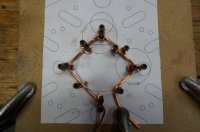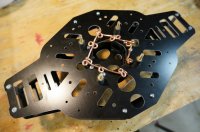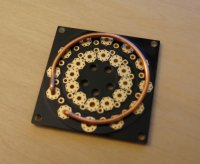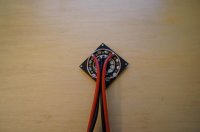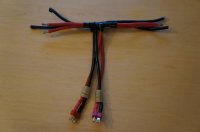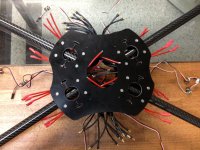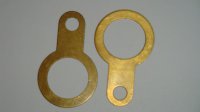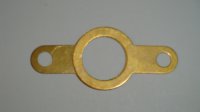Bartman
Welcome to MultiRotorForums.com!!
Been working on a new helicopter and posted this in the build thread last night but this may be worth its own discussion so here it is. In looking around the internet there are a lot of power distribution boards popping up but they're limited in how much current they can handle.
I've got a couple of the available boards on my bench and I'm trying to see what can be done with them but I"m also playing around with a new idea to get power from dual batteries to eight ESC's. What I've done is identified where I want my solder connections to be and have put a loop at each spot. There are also loops to the batteries and four loops for mounting studs to go through. The idea would be to make a positive and negative one of these and then stack them. I've also thought about sliding a short piece of silicone surgical (a.k.a fuel) tubing between each loop for insulation. As each wire is soldered into place, heat shrink could be slid onto the individual loops to insulate them as well.
Here's a pic of the first try at this and a pic of it sitting on my frame.
View attachment 4742View attachment 4743
I'm also trying a modification of the Zoltair power board using a short length of 14 AWG solid wire. THe board has holes at each solder pad and the pads extend from the top surface to the bottom. These boards are really versatile and weigh a third of what my two copper loops would weigh. The idea is to solder the wire to each pad around the bottom so it adds to the current capacity of the board.
View attachment 4744
Bart
I've got a couple of the available boards on my bench and I'm trying to see what can be done with them but I"m also playing around with a new idea to get power from dual batteries to eight ESC's. What I've done is identified where I want my solder connections to be and have put a loop at each spot. There are also loops to the batteries and four loops for mounting studs to go through. The idea would be to make a positive and negative one of these and then stack them. I've also thought about sliding a short piece of silicone surgical (a.k.a fuel) tubing between each loop for insulation. As each wire is soldered into place, heat shrink could be slid onto the individual loops to insulate them as well.
Here's a pic of the first try at this and a pic of it sitting on my frame.
View attachment 4742View attachment 4743
I'm also trying a modification of the Zoltair power board using a short length of 14 AWG solid wire. THe board has holes at each solder pad and the pads extend from the top surface to the bottom. These boards are really versatile and weigh a third of what my two copper loops would weigh. The idea is to solder the wire to each pad around the bottom so it adds to the current capacity of the board.
View attachment 4744
Bart

